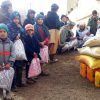
Save the Children: 30% of Afghan Children to Face Crisis Hunger in 2024
27 May 2024
Approximately 6.5 million children in Afghanistan, accounting for nearly 30% of the child population, are anticipated to face severe or crisis levels of hunger this year, largely due to floods, prolonged drought, and the influx of returning Afghan refugees from Pakistan and Iran, according to Save the Children.
The Integrated Food Security Phase Classification (IPC) projects that 28% of the Afghan population, or around 12.4 million individuals, will encounter acute food insecurity by October. Of these, nearly 2.4 million are expected to experience emergency hunger levels, just short of famine.
Despite a slight improvement from the October 2023 report, these figures highlight the ongoing need for aid, with poverty affecting half of Afghanistan’s population. In May, heavy rains and flash floods in Northern Afghanistan resulted in over 400 deaths, destroyed or damaged thousands of homes, and ravaged farmland.
In response, Save the Children has deployed a mobile clinic in Baghlan as part of its emergency program. The organization estimates that 2.9 million children under five will suffer from acute malnutrition in 2024.
“When my children are hungry, they become sad, which deeply affects me,” said Mariam, the mother of a child named Firoz. “We have some food, but it is insufficient. We cannot afford enough for everyone. Some days we have full meals; other days we do not.”
Nawid, a member of a Save the Children health team in Northern Afghanistan, added, “Families here face severe financial difficulties. They have land but lack water and resources for farming, leading to joblessness. This impacts children who may miss school or need to work to support their families, leading to malnutrition and other health issues.”
The slight improvement in child hunger rates is attributed to extensive humanitarian aid and a potentially better harvest. However, food aid is expected to decline due to funding cuts.
Since September 2023, over 557,000 Afghans have returned from Pakistan following an ultimatum for undocumented foreigners to leave or face deportation. Nearly half of these returnees are children, contributing to increased hunger levels in areas like Jalalabad, where competition for jobs is fierce.
Arshad Malik, Country Director for Save the Children in Afghanistan, stated, “Save the Children has treated over 7,000 children for severe or acute malnutrition this year. These numbers underscore the need for sustained support for families facing ongoing challenges. Children are enduring the severe impacts of three years of drought, high unemployment, and the return of more than 1.4 million Afghans from Pakistan and Iran. Long-term, community-based solutions are essential to help families rebuild their lives.”
“The improvement in projected acute hunger rates is promising, but without increased international support, this trend could reverse. Only 16% of this year’s humanitarian response plan has been funded, yet nearly half the population requires assistance. This is not the time for the world to turn away.”
there is not post in layout 2

Regional Discussions on Afghanistan Intensify Ahead of Doha Summit
As the Doha meeting nears, special envoys from various nations,...















